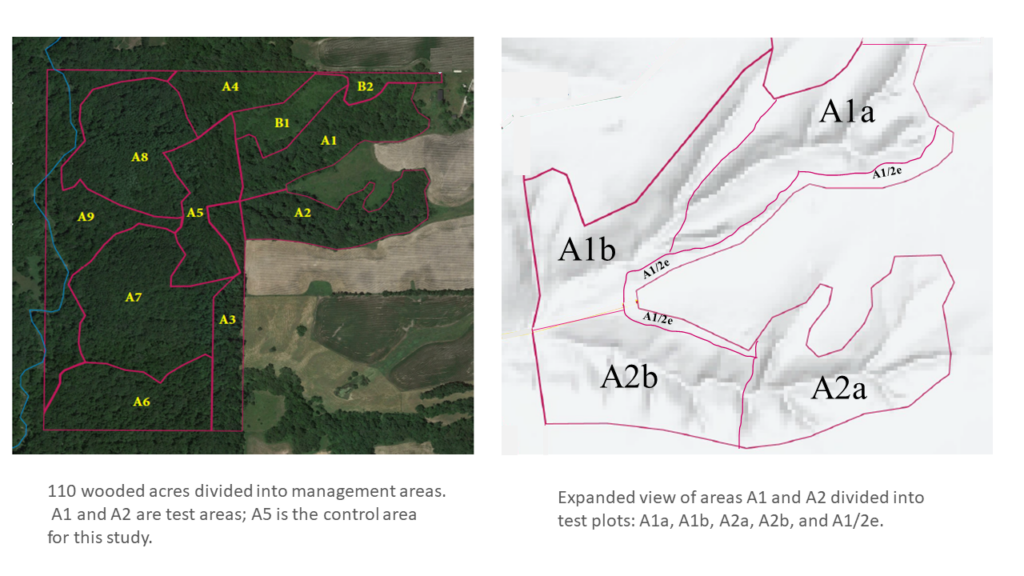Project Overview
Commodities
- Animals: goats
Practices
- Animal Production: grazing management
- Natural Resources/Environment: habitat enhancement, Invasive Species Control; Prescribed Burn Preparation
Proposal summary:
Prescribed burning is an important forest management tool, but a
heavy infestation of invasive bush honeysuckle (Lonicera
spp.) removes that tool from the toolbox. Bush honeysuckle kills
herbaceous groundcover, which is required fuel for a prescribed
fire.
Bush honeysuckle blocks sunlight to the forest floor by leafing
out first in the spring and keeping its leaves longest in the
fall. Additionally, it creates a dense understory that shades the
forest floor during the growing season. Honeysuckle also takes
moisture and nutrients away from native plants. A severe
honeysuckle infestation results in little, if any, herbaceous
groundcover underneath. A prescribed burn, necessary to improve
forest health, is simply not possible because there is no fuel
for a fire.
The problem to be solved is how to control bush honeysuckle in an
environmentally sound, sustainable way, that is, without the use
of herbicides. To be successful, the control method must reduce
honeysuckle sufficiently to allow establishment of enough
herbaceous groundcover for a good quality prescribed burn in the
future.
Project objectives from proposal:
Objectives:
- Compare non-herbicide methods for control of invasive bush
honeysuckle on 20.6 acres divided into five test plots.
Treatments include targeted goat grazing, manual mechanical
cutting, and machine shredding. - Evaluate the effectiveness of lightly seeding native grasses
during goat grazing to determine if seeding enhances herbaceous
groundcover - Assess which methods promote sufficient herbaceous
groundcover to enable a future prescribed burn - Determine which method, if any, should be expanded to larger
acreage on my farm - Share findings with the community to encourage
environmentally sound approaches for brush control
[caption id="attachment_1041464" align="alignnone" width="640"]
 Image of Woods[/caption]
Image of Woods[/caption]
Solution:
Two areas, A1 and A2, have been identified within 110 wooded
acres, and divided into five test plots (see attached image).
Adjacent area A5 will be used as an untreated control for the
study. Areas A1 and A2 both have steep ravines (up to 60% slope)
with incised creeks running through the bottoms. All areas have a
thick understory of bush honeysuckle, a severe infestation. The
table below summarizes the study design.
|
Method number |
Test plot |
Acreage |
Pretreatment (winter 2023) |
Treatment 1 (spring 2024) |
Treatment 2 (fall 2024) |
Treatment 3 (spring 2025) |
|
1 |
A1a |
5 |
None |
Goats |
Goats |
Goats&Cut |
|
2 |
A2a |
4.8 |
None |
Goats |
Cut |
TBD |
|
3 |
A1b |
5 |
None |
Goats |
Goats&Cut |
TBD |
|
4 |
A2b |
4.8 |
None |
Goats&Cut |
Goats |
TBD |
|
5 |
A1/2e |
1 |
Mulch |
Goats |
Goats |
TBD |
In the table, “Mulch” means shredding with a mulching head on a
skid steer (a flat, narrow area at the edge of A1 and A2 is
machine accessible). “Goats&Cut” means after goats have
grazed for a week or so, then manually cut honeysuckle taller
than goat-graze height to near ground level. “Cut” means manually
cut all honeysuckle with chain saws and hand tools to near ground
level. “TBD” means to be determined based on treatment
effectiveness in 2024.
Goats can graze to a height of six feet, whereas honeysuckle
grows up to 15 feet. Therefore, mechanical cutting is included in
each method to drop tall honeysuckle to near ground level.
Targeted goat grazing will be managed by Grazing Goats Wisconsin,
a firm that owns the goats and takes responsibility for all
aspects of goat grazing. Goats will be allowed to graze in mobile
paddocks with portable electric fencing and a solar-charged power
source. When the goats have sufficiently grazed an area, the
fencing will be moved to the next grazing area.
Test plots A1b and A2b will be grazed concurrently along with the
adjacent portion of A1/2e using two herds of 250 goats each (500
goats total) at a stocking rate of 50 goats per acre. The fencing
will then be moved to concurrently graze A1a and A2a along with
adjoining A1/2e. Goat grazing 20.6 acres is expected to take up
to 30 days for the first treatment, and less time for subsequent
treatments.
Spring grazing will defoliate brush while fall grazing will
defoliate but also allow the goats to eat honeysuckle berries.
After passing through the goats’ digestive tracks, honeysuckle
seeds may no longer be viable.
To test the value of seeding, native grass seed (~1 lb/acre) will
be hand broadcast on half of each test plot during grazing in
spring 2024. Goat hooves should help push seeds into the soil.
This study should answer the question of which method, with or
without seeding, provides the best preparation for a future
prescribed burn.